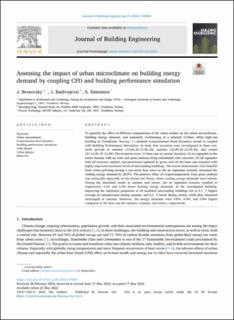| dc.contributor.author | Brozovsky, Johannes Georg | |
| dc.contributor.author | Radivojevic, Janja | |
| dc.contributor.author | Simonsen, Are Johan | |
| dc.date.accessioned | 2022-06-16T13:50:55Z | |
| dc.date.available | 2022-06-16T13:50:55Z | |
| dc.date.created | 2022-06-08T10:08:00Z | |
| dc.date.issued | 2022 | |
| dc.identifier.citation | Journal of Building Engineering. 2022, 55, 1-24. | en_US |
| dc.identifier.issn | 2352-7102 | |
| dc.identifier.uri | https://hdl.handle.net/11250/2999094 | |
| dc.description.abstract | To quantify the effect of different compositions of the urban surface on the urban microclimate, building energy demand, and summerly overheating of a selected 13-floor office high-rise building in Trondheim, Norway, a validated Computational Fluid Dynamics model is coupled with Building Performance Simulation. In total, four scenarios were investigated in three one-week periods in summer (15.06.20–21.06.20), autumn (16.09.20–22.09.20), and winter (21.12.20–27.12.20). The scenarios were: (1) base case or current situation; (2) no vegetation in the entire domain with no trees and grass surfaces being substituted with concrete; (3) all vegetation with all concrete, asphalt, and pavements replaced by grass; and (4) the base case situation with highly improved insulation levels of surrounding buildings. The results demonstrate clear benefits from urban greening during a one-week heat wave as the no vegetation scenario increased the cooling energy demand by 28.5%. The positive effect of evapotranspiration from grass surfaces was noticeable especially on the lowest two floors, where cooling energy demands were halved. During the simulated weeks in autumn and winter, the no vegetation scenario resulted in respectively 3.5% and 0.9% lower heating energy demands. At the investigated building, improving the insulation properties of all modeled surrounding buildings led to 0.1 °C higher average air temperatures during summer, and 0.1 °C lower during winter, while they remained unchanged in autumn. However, the energy demands were 0.8%, 0.9%, and 0.8% higher compared to the base case for summer, autumn, and winter, respectively. | en_US |
| dc.language.iso | eng | en_US |
| dc.publisher | Elsevier | en_US |
| dc.relation.uri | https://www.sciencedirect.com/science/article/pii/S2352710222006945?via%3Dihub | |
| dc.rights | Navngivelse 4.0 Internasjonal | * |
| dc.rights.uri | http://creativecommons.org/licenses/by/4.0/deed.no | * |
| dc.subject | Materials | en_US |
| dc.subject | Urban physics | en_US |
| dc.subject | Cold climate | en_US |
| dc.subject | Building performance simulation | en_US |
| dc.subject | Computational fluid dynamics | en_US |
| dc.subject | Urban microclimate | en_US |
| dc.title | Assessing the impact of urban microclimate on building energy demand by coupling CFD and building performance simulation | en_US |
| dc.title.alternative | Assessing the impact of urban microclimate on building energy demand by coupling CFD and building performance simulation | en_US |
| dc.type | Peer reviewed | en_US |
| dc.type | Journal article | en_US |
| dc.description.version | publishedVersion | en_US |
| dc.rights.holder | © 2022 The Authors. Published by Elsevier Ltd. | en_US |
| dc.source.pagenumber | 24 | en_US |
| dc.source.volume | 55 | en_US |
| dc.source.journal | Journal of Building Engineering | en_US |
| dc.identifier.doi | 10.1016/j.jobe.2022.104681 | |
| dc.identifier.cristin | 2030133 | |
| dc.relation.project | Norges forskningsråd: 257660 | en_US |
| dc.source.articlenumber | 104681 | en_US |
| cristin.ispublished | true | |
| cristin.fulltext | original | |
| cristin.qualitycode | 1 | |

